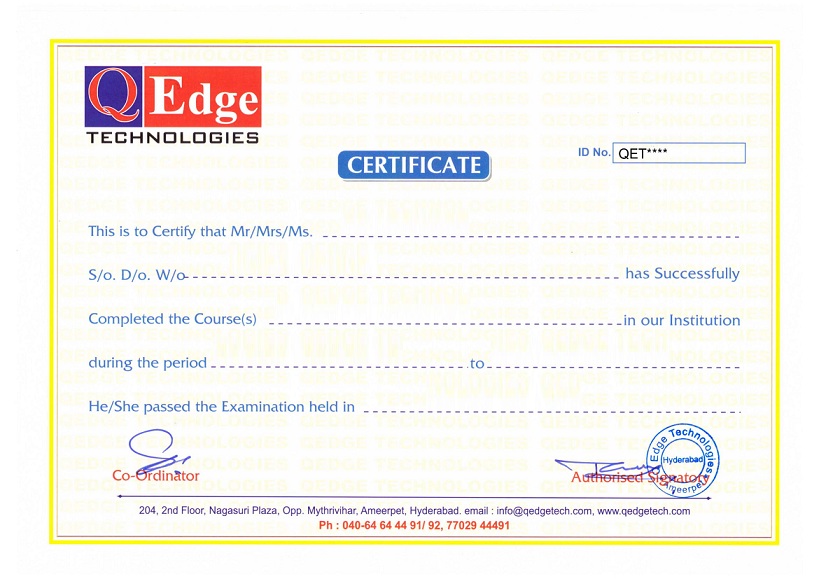- Home
- All Courses
- Software Testing & Selenium
- Selenium Automation Testing
- Live Projects on Testing
- Live Projects on Selenium
- DevOps with AWS & Azure
- Amazon Web Services
- React JS
- MERN Stack
- Java Full Stack By JavaEdge
- UI / WEB Development By JavaEdge
- Python Full Stack By PyEdge
- Django with Live Project By PyEdge
- New Batches
- Placements
- Student Reviews
- Students Zone
- Contact Us
- Enroll Now
DevOps Training in Hyderabad
QEdge Technologies is the Leading and Best training institute for Devops, AWS and other technologies in Ameerpet, Hyderabad. We have strong record of providing placement assistance in global MNC’s.
Course Duration
90 Days
Training Options
Classroom / Online
Rating
Why Should You Take DevOps Training in Hyderabad with AWS Course?
DevOps with AWS is in demand.
DevOps Engineering is rated as one of the happiest professions.
DevOps has a great career path.
Instructor-led DevOps with AWS Live Classes
| Course | Date | Timings | Duration | Trainer | Register for Demo |
|---|---|---|---|---|---|
| DevOps with AWS | 29-April-2024 | 09:00 AM - 10:30 AM | 90days | Mr. Satish | Register Now |
| Azure for Devops | 09:30 AM - 11:00 AM | 45days | Mr. Satish | Register Now |
About Course
We provide job oriented DevOps Training in Hyderabad with best infrastructure for both classroom and online training. We offer Online Training to Global students as well like from US, UK, Europe, Australia.
DevOps is the culture in software development, in which Software developers combine with the operations team to ensure that the applications and services are delivered at high velocity and performs with a minimum number of problems.
This improves products at a faster pace than organizations using traditional software development and infrastructure management processes. In the competitive markets this speed enables the organizations to better serve their customers.
Development and operations teams are sometimes merged into a single team where the entire application life-cycle involves engineers, from development and test to deployment to operations, and develop a range of skills not limited to a single function.
Kindly, register with us for more information on course details. Our representative will get back to you soon.
About Trainer
• 10+ years of Real-time Experience in DevOps Engineer
• Expert in DevOps Tools like Kubernetes, Vagrant, Ansible, Docker, AWS, Linux etc.,
• Certified DevOps Consultant
• Experience in blend of Real-time Projects & Training’s
Training Options
CLASSROOM TRAINING
INR 20,000/-
- Effective Training by Industry Experts
- High-End Training Infrastructure
- Limited Students per batch
- Personalized & Focused Learning methodology
- Study Materials, Videos and Tests through LMS App
- Assignments assessment and assurance
- Certification , Resume & Placement Support
ONLINE TRAINING
INR 20,000/-
- Smartboard & Live Video Streaming Environment
- Effective Training by Industry Experts
- Limited Students per batch
- Assignments assessment and assurance
- Study Materials, Videos and Tests through LMS App
- Earn a Global Certificate
- Resume & Placement Support
Video Based Learning
INR 20,000/-
- High Quality Training Videos by Industry Experts
- Learn at your convenient time
- Videos Access
- Free Upgrade & Support
- Study Material and Tests access through LMS
- Earn a Global Certificate
- Resume & Placement Support
Skills Covered












Curriculum
Why DevOps Training in Hyderabad
- Business Perspective
- IT Perspective
- Developer Perspective
- Tester Perspective
- Operations Perspective
What is DevOps
- Definition
- Stakeholders of DevOps
- What is SDLC
- Phases of SDLC
- Role of Dev in SDLC
- Role of Ops in SDLC
What is Agile and Scrum?
- Agile Development Process
- Agile Manifesto
- Agile Scrum Work Flow
- Agile Analysis Estimation Techniques
- Types of Roles and Responsibilities
- Problem That DevOps Solves
- Making a DevOps Transition
- Introduction to DevOps Automation
- Role of Dev in Agile Scrum
- Role of Ops in Agile Scrum
Problem which resolves DevOps Implementation in Project Implementation
DevOps Life Cycle
- Introduction to DevOps Automation
- Tools
- DevOps Technology Categories
- Collaboration
- Planning
- Issue Tracking
- Monitoring
- Configuration Management
- Source Control
- Dev Environments
- Continuous Integration
- Continuous Testing
- Continuous Deployment
Linux Essentials for DevOps
- Linux Overview
- What is Operating system
- What is Unix, Linux
- Unix vs Linux
- Linux Distributions
- Linux Architecture & Installation
- Linux Boot process
- Linux commands
- Linux admin level commands
- Reading files
- Redirection operators
- User management
- Group management
- File system management
- Linux volume manager hands on
- Linux installation using iso
- Directory structure
- Editors
- VMware overview
BASH Scripting
- Role of Shells in Linux Environment
- Types of shells
- Shell Commands
- Command line arguments
- Variables
- Types of Operators
- Conditional Statements
- Bash Loops
- Case statement
- Functions
- Interactive Scripts
- Awk
- Sed
- Script Programs
GIT
- Introduction
- What is a Version Control System (VCS)? Distributed Vs Non-distributed VCS
- What is Git and where did it come from?`
- Alternatives to Git
- Installation and Configuration
- Obtaining Git Installing Git
- Common configuration options GUI tools
- Key Terminology
- Clone Working Tree Checkout Staging area Add
- Commit Push Pull Stash
- Git – Local Repository Actions Creating a repository (git init) Checking status (git status)
- Adding files to a repository (git add) Committing files (git commit) Removing staged files (git reset) Removing committed files (git rm) Checking logs (git log)
- Git – Remote Repository Actions Creating a remote repository (git init) Cloning repositories (git clone)
- Updating the remote repository from the local (git push) Updating the local repository from the remote (git pull)
- Tagging in Git What are Git Tags? Listing tags Lightweight tags
- Displaying tag details (tag show) Annotated tags
- Checking out tags Pushing tags Pulling tags
- Branching in Git
- What is a branch
- A note about <HEAD> Listing branches Create new branch Checkout branch Pushing branches Pulling branches Merging in Git
- Fetching Changes (git fetch) Rebasing (git rebase)
- Git Pull
- Git Workflows Different ways of using Git Centralized
- Feature Branch Gitflow Workflow Forking Workflow
- Creating a branch from a Stash Advanced Repository Actions Removing untracked files (git clean) Remove staged changes (git reset) Revert a commit (git revert)
- Checkout a previous commit (git checkout)
- Advanced Branching & Merging
- Deleting a Branch Fast forward merge Three way merge
- Real Time Use Case: Merge Conflicts
MAVEN (Build Tool)
- Issues before in manual process of build process
- Automated build process
- Introduction
- Maven Structure and Installation
- Maven Dependencies
- Maven Repositories
- Maven Plug-ins
- Maven Configuration
- Integration with SCM tools
- Maven Project
Jenkins
- What is Jenkins?
- Best Practices
- Installation and Configuraiton
- Pre-requisites
- Download & Install
- Configurations
- Jenkins plugins – how to download and use
- Parameterizing the build
- Overview of Continuous Integration (CI)
- What it means Continuous Integration? Fundamental of CI
- How CI helps to Agile Development History of Jenkins
- Where Jenkins Fit in Organization Overview of Jenkins community
- Install Jenkins on Ubuntu / Windows Configuring a Node
- Configuring Jenkins server
- Configure Dashboard Configure System Environment Global Properties
- Configure Build Tools Configure Proxy
- Working with Jenkins Build Job
- Create and Configure a job Run a job manually Triggering a Build Scheduled Build job Manual Build job
- Polling SCM
- Maven and ANT Build Step Execute a Shell
- Post-Build Actions Archiving Build Results Notifications
- Working with Automate Testing
- Advanced Jenkins
- File fingerprint tracking Parameterized Build Job Parameterized Trigger
- Automated Deployment and Continuous Delivery
- CI & CD Pipeline Deployment using pipeline Script
- Jenkins Plugins
- Secure and Notification in Jenkins
- Overview of Notification Email Notification
- Other Notification
- Best Practices on Jenkins
ANSIBLE (Configuration Management Tool)
- IT Automation
- History of IT Automation
- Advantages of IT Automation
- Disadvantages of IT Automation
- Types of IT Automation
- What is Ansible?
- Ansible Architecture
- Installing Ansible
- Installing Ansible on Linux OS
- Installing Ansible using the systems package manager
- Ansible Version and Configuration
- Working with inventory files
- Basic inventory file
- Groups in an inventory file
- Regular expression in the inventory file
- Automating Simple Tasks
- YAML Scripting
- Working with Playbooks
- Anatomy of a playbook
- Playbook commands
- Writing Playbooks
- Executing the Playbooks
- Variables in Playbooks
- Terminology in Playbooks
- Ansible Core Modules
- Ansible Ad-hoc commands
- Installing and configuring a web server
- Working with Handlers
- Ansible Role
Note: Realtime Use Case in Ansible integrate with Jenkins,Git and Maven
Vagrant
- Introduction
- What is Vagrant
- Virtualization Overview
- Setting Up Vagrant
- Virtual Box Installation
- Vagrant Installation
- Vagrant without Virtual Box
- Using Vagrant
- Vagrant Machine
- Vagrant Files
- Boxes
- Running Vagrant Machines
- SSH to Vagrant Machine
- Synced Folders
- Networking Basics
- Environment Management
- Boxes
- Vagrant Boxes
- Basic Box Management
- Creating Boxes from existing environment
- Creating custom boxes
DOCKER (Containerization Tool)
- Containerization Vs Virtualization
- Traditional Virtualization
- Containerization
- Understanding Docker
- Difference between Docker and Other VMs
- Docker file
- Docker Networking
- Docker Installation
- Docker Hub and expose to official images
- Docker Images registry
- Running the Docker Container
- Handling Docker Containers
- Docker Adv.Commands
- Docker Terminology
- Working with Docker Images
- Docker Hub
- Searching Docker images
- Docker file build instructions
- FROM instruction
- MAINTAINER instruction
- COPY instruction
- ADD instruction
- RUN instruction
- ENV instruction
- ARG instruction
- Environment variables
- USER instruction
- WORKDIR instruction
- VOLUME instruction
- CMD instruction
- ENTRYPOINT instruction
- SHELL instruction
- A Brief on the Docker image management
- Publish your build images into Docker Hub
- Understanding the Docker Hub
- Working with Containers
- What is container
- Docker run command
- Theory of pulling and Running Containers
- Container Life cycle
- Data Volume
- Sharing data between Containers
- Docker Swarm Mode
- Swarm Mode Theory
- Configuring Swarm Mode
- Services
- Scaling Services
- Rolling Updates
Note: Docker Real Time UseCases
KUBERNETES
- What is kubernetes
- Purpose of Kubernetes for micro services
- How kubernetes works
- Master components, how works
- Node Components, how works
- How pods works
- Installations and configuration kubernetes cluster
- Pod lifecycle
- Work with pods
- Work Services
Provisioning using Terraform
Goal: Learn how to provision and manage infrastructure on a Cloud Platform (AWS) using
Terraform Configuration Files.
Objectives
After completing this module, you should be able to
- Understand Provisioning using Terraform
- Learn the Difference between Terraform vs Ansible
- Understand Terraform Architecture
- Deploy a Terraform Configuration File
- Use Basic Terraform Commands
- Manage Terraform Resources
- Perform Terraform State Commands
Topics
- Introduction to Terraform
- Terraform vs Ansible
- Terraform Architecture
- Terraform Configuration
- Terraform Common Commands
- Managing Terraform Resources
- Terraform State
Hands-On
- Setting Up AWS and Terraform
- Executing a Terraform Configuration
- Managing Terraform Resources
- Referencing Terraform Resources
Terraform State commands
Introduction to Cloud Computing
- What is Cloud
- Why Cloud?
- Types of Cloud Deployment Models
- Types of Cloud Services
- Future of Cloud Technologies
- Advantages and Disadvantages of Cloud
Introduction to Amazon Web Services (AWS)
- What is AWS?
- How to Subscribe for AWS account
- What is the AWS Free Usage Tier
- AWS Certification
- Introduction to the AWS management Console
- List of services given by AWS
Elastic Compute Cloud (EC2)
- What is Amazon EC2?
- Features of Amazon EC2
- Managing the EC2 infrastructure
- EC2 Dashboard
- Pricing for Amazon EC2
Regions and Availability Zone Concepts
- Describing Regions
- Availability Zones, and Endpoints
- Managing instances in an Availability Zone
Amazon Machine Images (AMI)
- Managing AMIs
- Working with Windows, Linux AMIs
- Shared and Paid AMI
- Making an AMI Public
EC2 Instances
- Instance Type
- Instance life cycle
- Differences between reboot, stop, and terminate
- Building an EC2 windows and linux instances
- To install instance in public and private subnet
- Security via Key Pairs
- EC2 Class and VPC Security Groups
- Managing Elastic IP’s
- Pricing model in EC2 instances
- EC2 with Amazon command line interface
Amazon Elastic Block Store (EBS)
- Features of Amazon EBS
- Amazon EBS volumes
- Managing EBS volumes
- Increasing the volume size
- AmazonEBS snapshots
Load Balancing (ELB)
- Creating a load balancer
- Internal and external load balancer
- Load balancing protocols
- Security groups for the load balancer
- Health check for the load balancer
- Cross-zone load balancing
- Connection Draining
Auto Scaling
- What is auto scaling?
- Auto scaling components
Advantages of Auto Scaling
- Creation of launch configuration
- Configuration of auto scaling policies
- Advantages of using auto scaling with ELB
Network & Security
- Security Groups
- Elastic IPs
- Placement Groups
- Key Pairs
- Network Interfaces
Amazon Virtual Private Cloud (VPC)
- What is Amazon VPC?
- VPC Essentials
- Default and Nondefault VPC
- VPC Networking and ACL
- Security Groups
- DNS and DHCP Options Sets
- VPC Peering and Endpoints
- Subnet Routing
- VPC Internet Gateway
- Elastic IP addresses and network interfaces
- VPC integration with many other AWS services
- Creating a NAT instance in a VPC
- Configuring a Web application in VPC
- Pricing for Amazon VPC
Amazon Route 53
- Route 53 as your DNS service
- Using Traffic Flow
- Route 53 Health Checks
- Configuring DNS Failover
- Latency Based Routing
- Weighted Routing Policies
- Hosting web portal using Route53
- Bucket Policies
Identity Access Management (IAM)
- IAM Features
- Getting Started With IAM
- Creation of user, groups, roles
- Managing & Writing policies
- Credential Report
- IAM Console and the Sign-in Page
Amazon S3
- What is object Storage?
- Data as objects
- Lifecycles of S3
- Managing Buckets
- Accessing S3 storage via tools
- Creation of a static website using S3 storage
Relational Database Service (RDS)
- RDS Essentials
- Launching RDS instance
- Selecting the Engine
- Configuring the Database Engine
- Managing RDS Database
- Setting up automatic backups
- Authorizing access to the DB
Amazon Cloud Watch
- Amazon Cloud Watch Architecture
- List of services monitored by Cloud Watch
- Collect and track metrics
- Monitoring memory and disk Metrics
- Monitoring logs, Graphs
- Set Alarms
Amazon Security Groups and NACL
- What is Security Group?
- Where the Security Groups are used in AWS?
- What is NACL?
- Difference between NACL and Security Groups
- Implementation of Security Groups and NACL service
Cloud Formation
- Building AWS infrastructure as a code
- Design a template
- Create a Stack
- Create a Template from your Existing Resources
- Introduction to JSON
Amazon Simple Email Service (SES)
- Simple email service overview
- Configuring Amazon email service
- Amazon SES and Deliverability
- Amazon SES Email-Sending Process
- Email format and Limits of SES
Amazon Simple Queue Service (SQS)
- Simple Queue service overview
- SQS for background work task
- Creating a Queue
- Confirming the Queue exists
- Add a permission to the Queue
Amazon Simple Notification Service (SNS)
- Simple Notification Service overview
- SNS architecture
- Publishers and subscribers
- Creation of a topic
- Subscribing to topic via Email
- Setting notification for EC2 instance changes
What is Microsoft Azure?
Types of Azure Clouds
- Azure as IaaS
- Azure as PaaS
- Azure As SaaS
Azure key Concepts
Azure Domains (Components)
- Compute
- Storage
- Azure Networking
- Database
Overview of DevOps
- Why DevOps?
- What is DevOps?
- DevOps Market Trends
- DevOps Engineer Skills
- DevOps Delivery Pipeline
- DevOps Ecosystem
Version Control with Git
- What is version control
- What is Git
- Why Git for your organization
- Install Git
- Common commands in Git
- Working with Remote Repositories
Azure DevOps CI/CD pipelines
- Introduction to CI/CD
- Tasks
- YAML Templates
- Create .NET Core CI pipeline
- Create .NET Core CD pipeline
- Sonar cloud integration
Implement and manage build infrastructure
- Private and hosted agents
- Integrate third party build systems
- Recommend strategy for concurrent pipelines
- Manage Azure pipeline configuration (e.g. agent queues, service endpoints, pools, webhooks)
Deploying ARM Template in Azure
- Introduction to CI-CD ARM templates
- Create ARM template
- Create and Run ARM deployment CI pipeline
- Create and Run ARM deployment CD pipeline
Application Secrets in the pipelines
- Introduction to Azure Key vault
- Accessing Secrets from Azure Key Vault
- Linking Secrets from Azure Key Vault
Azure Artifacts
- Introduction to Azure Artifacts
- Create NuGet packages and Versioning
- Package management with DevOps
- Maven packages
Continuous Integration using Jenkins
- Jenkins Management
- Adding a slave node to Jenkins
- Building Delivery Pipeline
- Pipeline as a Code
Implementation of Continuous Testing with Selenium
- Introduction to Selenium
- Why Selenium?
- Selenium – Webdriver
- Creating Test Cases in Selenium WebDriver (Waits)
- What and why X-Path
- Handling different controls on Webpage
- Framework in Selenium
- Selenium Integration with Jenkins
- Integrating Selenium with Jenkins
Continuous Deployment: Containerization with Docker
- Shipping Transportation Challenges
- Introducing Docker
- Understanding images and containers
- Running Hello World in Docker
- Introduction to Container
- Container Life Cycle
- Sharing and Copying
- Base Image
- Docker File
- Working with containers
- Publishing Image on Docker Hub
Containerization with Docker: Ecosystem and Networking
- Introduction to Docker Ecosystem
- Docker Compose
- Docker Swarm
- Managing Containers
- Running Containers
- Introduction to Docker Networking
- Network Types
- Docker Container Networking
Configuration Management with Ansible
- Introduction to Ansible
- Ansible Installation
- Configuring Ansible Roles
- Write Playbooks
- Executing adhoc command
Like the curriculum? Enroll Now
Structure your learning and get a certificate to prove it.

DevOps with AWS
QEdgeTech DevOps Training in Hyderabad Professional Certificate Holders work at 100s of companies like




Reviews



QEdge Training Features

Theory

Project Work

Assignments

Certification

Resume Preparation

Interview Preparation

Resume Marketing

Placement Support
Frequently Asked Questions
Daily 1.5 hour theory + 1.5 hour practical session.
Monday to Saturday Sessions.
The DevOps project work in this course entails several key components. Firstly, students will be tasked with setting up a comprehensive LAMP (Linux, Apache, MySQL, PHP) environment. This involves installing and configuring each component to ensure seamless integration and optimal performance.
Additionally, the project work requires students to meticulously configure the web, database, and application layers within the LAMP environment. This step involves fine-tuning various settings and aligning them with specific project requirements to guarantee smooth functionality and efficient data processing.
Furthermore, the implementation of system monitoring tools is an important aspect of the project work. Students will learn how to select and deploy appropriate monitoring solutions to ensure the continuous tracking and analysis of the LAMP environment’s performance. This enables prompt identification and resolution of any issues that may arise during system operation.
Overall, this project work provides students with the opportunity to apply their knowledge of DevOps concepts and tools in a practical setting. By undertaking this real-world scenario, students can gain valuable hands-on experience in the various stages of DevOps project development.
In DevOps, build automation is implemented through the use of Maven. Maven is a powerful tool that is specifically designed for build automation purposes. It provides a structured approach to managing and organizing projects, making it an ideal choice for DevOps teams.
To implement build automation using Maven, participants in the DevOps training are introduced to its core concepts and functionality. They learn about the structure and phases of Maven, gaining an understanding of how Maven manages the build process. This includes learning about the various lifecycle phases that Maven supports, such as compilation, testing, packaging, and deployment.
Installing Maven is an essential step in the build automation process. The training covers the detailed steps needed to install Maven on different operating systems, ensuring that participants have the tools necessary for successful build automation.
Configuration is another important aspect of implementing build automation with Maven. Participants learn how to configure Maven to suit their specific project requirements. This includes setting up dependencies, repositories, and plugins, among other configurations.
In addition to understanding Maven’s structure and configuration, participants also learn about the commonly used jar/war project structure in build automation. This structure provides guidelines on organizing the source code and resources within a project, enabling efficient build automation and deployment.
By mastering Maven and its associated concepts, participants in the DevOps training gain the knowledge and skills needed to effectively implement build automation. This prepares them to streamline the build process, improving the efficiency and reliability of software development within the DevOps environment.
In DevOps, environments refer to distinct spaces or configurations where applications and software are developed, tested, and deployed. These environments serve different purposes throughout the software development lifecycle. Four common types of environments in DevOps are:
1. Development Environment: This environment is used by developers to write, modify, and test code. It provides a space for programmers to work on individual components of a software application without affecting the main production environment. Developers can experiment, collaborate, and ensure that the code functions as intended in this controlled environment.
2. Testing Environment: Once the development phase is complete, the software moves to the testing environment. Here, Quality Assurance (QA) engineers thoroughly test the application for bugs, errors, and potential issues. Various types of testing, such as unit testing, integration testing, and performance testing, are conducted in this environment to ensure the application meets the desired quality standards.
3. Staging Environment: After successful testing, the software is deployed to the staging environment. This environment closely resembles the production environment and serves as a final checkpoint before the software is released to end-users. The staging environment allows for additional testing and validation, enabling teams to verify the application’s performance and functionality in an environment that closely mirrors the production setup.
4. Production Environment: The production environment is the live or operational environment where the software is made available to end-users. It is a fully functioning system that reflects the actual user experience. The production environment is carefully configured to optimize reliability, security, and performance. Continuous monitoring and maintenance are crucial in this environment to promptly respond to any issues that may arise.
By utilizing different environments, DevOps teams can ensure a systematic and thorough approach to software development, from initial development to final deployment. This segregation of environments allows teams to maintain control, conduct comprehensive testing, minimize risks, and deliver high-quality software to end-users.
Yes, you are going to work on real-time projects during learning to gain real-time projects experience.
The revision control system used in DevOps is Git. Git is a powerful tool that allows for effective management of code and version control. It supports features such as local and remote repositories, branching, merging, cloning, fetching, pulling, and the installation of Git Server. With Git, developers can collaborate seamlessly, track changes, and safely manage multiple versions of their codebase. Its popularity and flexibility make it the preferred revision control system in the world of DevOps.
The course covers a range of automation concepts that are essential for streamlining and optimizing various processes. These concepts include:
1. Operating System Basics: Understanding the fundamentals of operating systems is crucial for automation. Students will learn about different operating system components and their roles in automating tasks.
2. Scripting Introduction: This module introduces students to the basics of scripting languages. They will learn about the syntax, variables, data types, and control structures required to write efficient scripts.
3. Shell Scripting: Shell scripting is a key aspect of automation. Students will gain a comprehensive understanding of shell scripting languages, such as Bash, and learn how to automate repetitive tasks by writing scripts.
4. Database Concepts: Automation often involves working with databases. This section covers fundamental database concepts, including data manipulation, querying, and scripting to automate database-related tasks.
5. Shell Variables, Decision Making, and Shell Test Conditions: Automating tasks requires the ability to handle variables, make decisions based on conditions, and test different scenarios. Students will learn how to utilize shell variables, implement decision-making logic, and perform effective shell test conditions.
6. Shell Loops, Redirection, and Exit Status: Loops are essential in automation to execute repetitive tasks. This module provides a deep understanding of different loop structures available in shell scripting. Additionally, students will master the redirection of input and output streams to automate data processing. Understanding and interpreting exit status codes will also be covered.
By completing this course, students will gain a strong foundation in automation concepts, enabling them to automate various tasks efficiently and effectively.
Installing WordPress with LAMP in a DevOps environment involves several steps.
First, an introduction to Vagrant is necessary. Vagrant is a tool used to create and manage development environments. It allows for easy configuration and reproducibility of virtual machines. Understanding Vagrant terminologies, such as boxes and provisioners, is essential.
Next, the installation of Vagrant is required. This can be done by downloading and installing the Vagrant software from the official website. Once installed, Vagrant can be used to manage the virtual machine on which WordPress will be hosted.
To enable WordPress installation with LAMP, the LAMP stack needs to be set up. LAMP stands for Linux, Apache, MySQL, and PHP. Linux is the operating system, Apache is the web server, MySQL is the database, and PHP is the programming language used for WordPress.
Once the LAMP stack is installed on the virtual machine, we can proceed with the installation of WordPress. WordPress is a widely used content management system (CMS) for building websites and blogs. It requires a PHP-compatible web server and a MySQL database. By utilizing the LAMP stack, all the necessary components are in place.
Additionally, Docker is another tool that can be utilized in DevOps for managing and deploying applications. With Docker, it is possible to create lightweight containers that encapsulate the application and its dependencies. Understanding Docker terminologies, such as images and containers, is important.
After Docker is installed, Docker images can be created for WordPress. These images contain all the necessary components and configurations to run a WordPress instance. Docker brings the advantage of portability and scalability, making it easier to manage WordPress installations across different environments.
In summary, installing WordPress with LAMP in a DevOps environment involves the utilization of tools like Vagrant and Docker. Vagrant helps set up and manage the virtual machine, while Docker enables the creation and deployment of lightweight containers for WordPress. With this approach, developers can easily manage and scale their WordPress installations in a reliable and reproducible manner.
After completion of training, you will receive a certificate of completion, which you can share with your friends, relatives, co-workers and potential employers.
Yes, you’ll be able to access your enrolled course materials through our Learning Management System. Practical Assignments, Day-to-Day Class videos and readings you can access through our LMS App.
Be Future Ready. Enroll Now
Structure your learning and get a certificate to prove it.

QEdge Technologies
QEdge Technologies was established by team of enthusiastic industry professionals from various organizations with the vision of providing IT training to fill the gap between industry requirement and learning.
Follow us!
Contact Us
Full Stack Developer Trainings
- Java Full Stack Training
- Python Fullstack Training
- Django with Live Project
- UI / WEB Development
- React JS
- MERN Stack
Software QA Testing Trainings
- Software Testing Training Online
- QA Testing Training
- Selenium Training
- Manual Testing Training
- Selenium Project Testing Training
- Manual Project Testing Training
- Appium Mobile Application Testing Training
- JMeter Performance Testing Training
- LoadRunner Performance Testing Training
- Database & ETL Testing Training
- Copyright © 2021 QEdge Technologies
- Terms & Conditions
- Legal & Privacy






